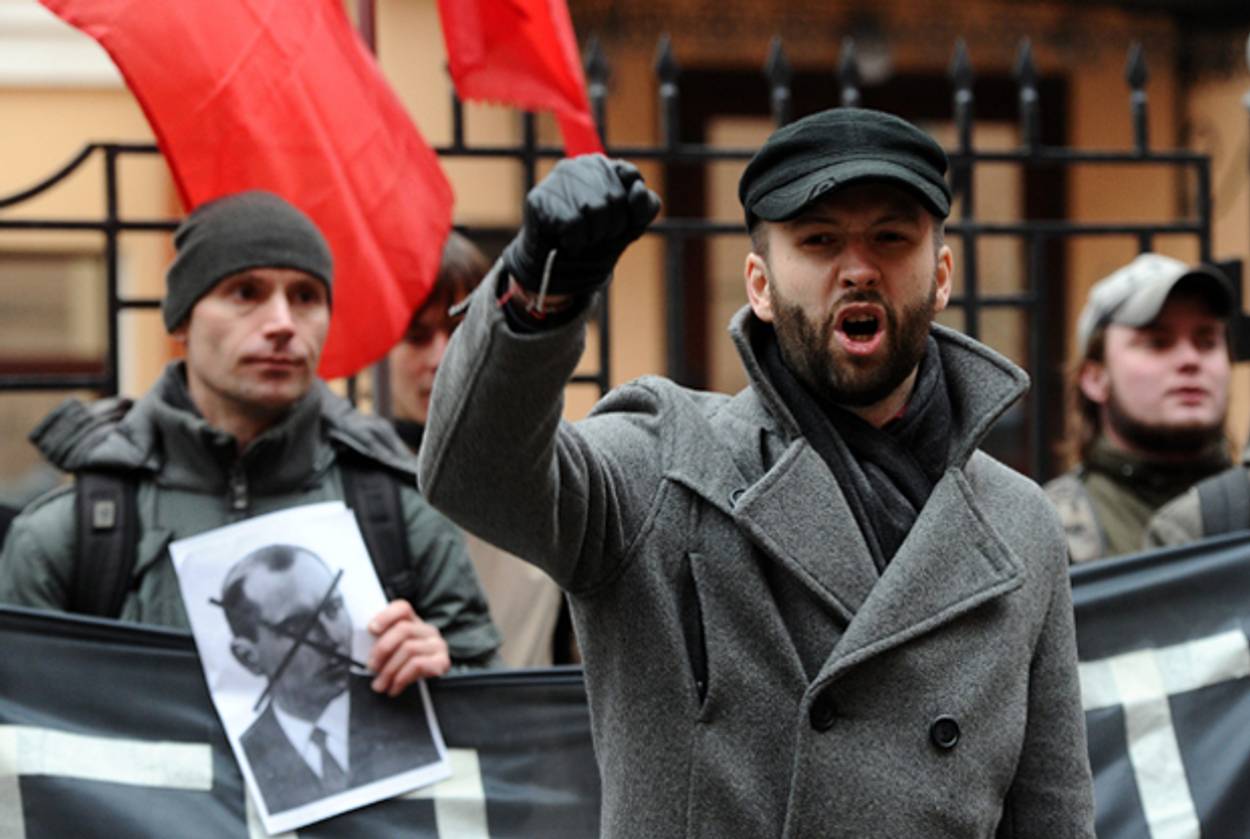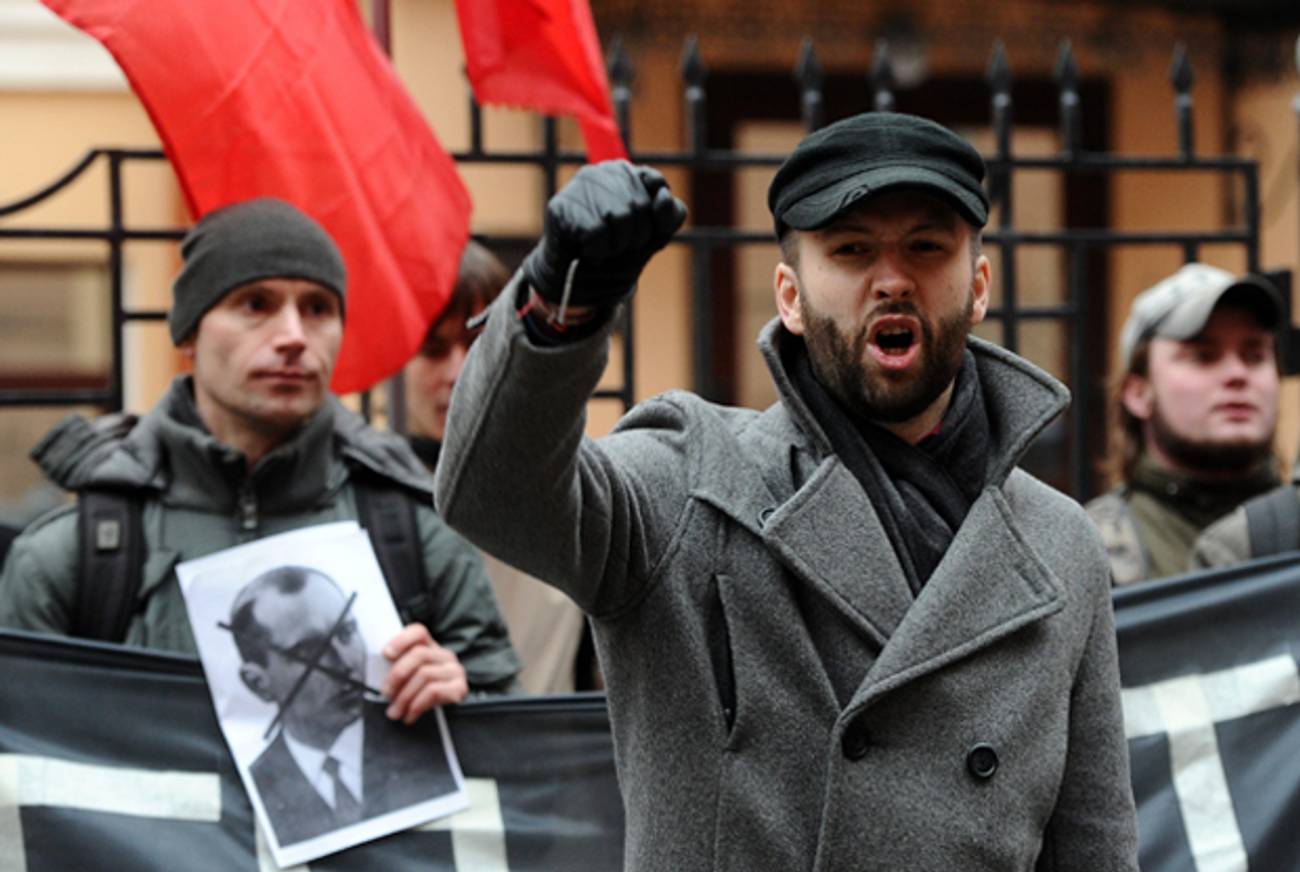Why Are Jews So Afraid of Stepan Bandera?
Historians explain the man of the moment in Ukraine




Over the past week, one man has become, seemingly, a symbol of everything to be feared by Jews and other minorities—chiefly ethnic Russians—in Ukraine: Stepan Bandera. Who was he?
Born in 1909 in what was then Austria-Hungary, Bandera led one of the factions of the Organization of Ukrainian Nationalists, a proto-fascist movement that advocated sovereignty for ethnic Ukrainians—and the removal of other ethnic groups from Ukrainian territory. In the 1930s, this meant primarily Poles, because Ukraine was then under Polish rule. Bandera spent five years in prison, and was only released after the Soviet invasion in 1939.
Under Soviet occupation, the OUN had a new barrier to Ukrainian independence and thus a new enemy to fight against. But they also found themselves with a new—or perceived—ally: The Nazis. At the time, Ukraine’s Jews were naturally Soviet partisans, and that made them targets for Bandera and the OUN. “Ukrainian nationalists who wanted a Ukrainian state saw the Jews rejoicing when the Soviets invaded, getting top positions in Soviet government, and they decided to take out their ire against the Jews,” said Jeffrey Veidlinger, an expert in modern Russian and Eastern European Jewish history at the University of Michigan.
On June 30, 1941, the Germans entered the western Ukrainian city of Lviv. Bandera’s nationalists joined Nazi Einsatzgruppen in carrying out pogroms against the city’s Jews, along with political prisoners and opposition members. (Bandera himself was in Krakow.) The same day, the OUN declared an independent Ukrainian state; when Hitler refused to acknowledge the state, Bandera was imprisoned for refusing to rescind the declaration, and he spent the rest of the war in Sachsenhausen. His brothers were sent to Auschwitz, where they died. In 1944, Bandera was released, but as Timothy Snyder has written, his fellow nationalists told him not to return to Ukraine out of fear for his life. “Thousands of Ukrainians died fighting for independence under his name,” Snyder wrote in 2010. “It is this legacy of sacrifice that many in western Ukraine today associate with Bandera, and do not wish to be forgotten.”
So while Bandera and his men were responsible for killing Jews, their ideology wasn’t fundamentally anti-Semitic; rather, it was pro-Ukrainian, and anti- everyone who appeared to be in the way of that, which included the pro-Soviet Jews. “For the Nazis, anti-Semitism was an unconditional core belief, and Nazi anti-Semitism was an all-or-nothing proposition that was both immutable and immune to circumstances,” explained Alexander John Motyl, a professor of political science at Rutgers, in an email. “For the Ukrainian nationalists, their attitude toward Jews depended on political circumstances.” The primary enemy of the OUN was Poland and then the Soviet Union—or, rather, Poles and Russians. Jews were a “problem” because they weren’t Ukrainian, and because they were implicated, or believed to be implicated, in helping the Soviets take over Ukrainian territory. Indeed, Motyl noted, the resolutions of the Second Great OUN Congress, held in Krakow in April 1941, on the eve of the German invasion, specifically cautioned Ukrainians against anti-Jewish activity and pogroms. Of the 63 attempted and actual assassinations carried out by Ukrainian nationalists in the interwar period, only one was directed against a Jew. Compare this with 36 Ukrainians, 25 Poles, and a Russian.
Motyl argues that the OUN should be understood as a typical national liberation movement along the lines of the PLO, the IRA—or even the Stern Gang. “All had hierarchical structures, employed violence, and acknowledged supreme leaders,” Motyl wrote. “All committed acts of violence against their perceived national enemies. All committed terrorism. All had authoritarian structures. Stepan Bandera was the Ukrainian version of Ahmed Ben Bella, Yasser Arafat, Menachem Begin, Avraham Stern, and Billy McKee.”
Bandera, who never returned to Ukraine, was killed in Munich in 1959, probably by the KGB—making him the ultimate martyr to the Ukrainian cause, and the ultimate bugaboo for Soviet propagandists, who began referred to Ukrainian nationalists as banderovtsi. But when the Soviet Union collapsed in 1991, Ukrainians—like all the other non-Russians—began questioning Soviet propaganda. Suddenly, banderovtsi became a thing to be proud of—a badge of honor in fighting the suddenly-bad Soviets. Today, his legacy lives on, repurposed to suit current problems. “Bandera and the nationalists are also seen as the polar opposites of the corrupt, incompetent, and venal Ukrainian elites who have misruled Ukraine for the last 20 years,” Motyl wrote. Which is why Viktor Yuschenko, the former president and hero of Ukraine’s 2004 Orange Revolution, bestowed Bandera the honor of being named a “Hero of Ukraine” in 2010, in an effort to retain his popularity.
Now, in the wake of Maidan—and in the midst of a power play by Vladimir Putin in Crimea, Bandera’s name signifies Ukraine’s struggles to be free of Russia, rather than a staunch commitment to anti-Semitism. As Snyder wrote in 2010, “To glorify Bandera is to reject Stalin and to reject any pretension from Moscow to power over Ukraine.”
Previous: Putin Defends Ukraine’s Jews, Slams Ukraine’s Jewish Oligarchs
Related: For the Kremlin, Ukrainian Anti-Semitism Is a Tool for Scaring Russians in Crimea
Batya Ungar-Sargon is a freelance writer who lives in New York. Her Twitter feed is @bungarsargon.